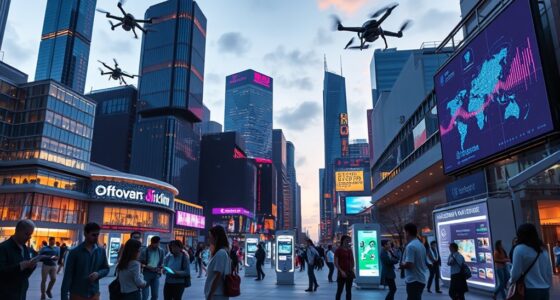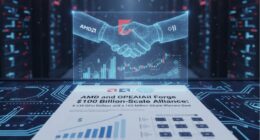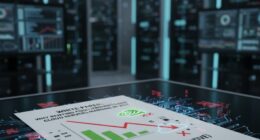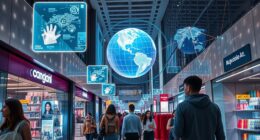Post-labor inflation happens when wages stay stagnant while the prices of cheap goods fall. Despite some wage growth, it’s often not enough to keep up with rising living costs, leaving you with less purchasing power. When inexpensive products become more available or cheaper, it may seem good at first, but combined with unchanged wages, it can actually hurt your financial situation. To understand the full impact and what’s driving this trend, keep exploring how today’s economy works.
Key Takeaways
- Cheap goods limit inflationary pressures, but rising wages may still erode consumers’ real purchasing power.
- When wages are stagnant or growing slowly, inflation driven by supply issues impacts affordability more.
- Increased prices from supply chain disruptions outpace wage growth, reducing consumers’ effective income.
- The collision of cheap goods with idle wages worsens income inequality and hampers consumer spending.
- Persistent supply chain issues keep prices high despite stagnant wages, fueling post-labor inflation dynamics.

Have you noticed how prices have been climbing relentlessly since the pandemic? It’s as if everything costs more, from groceries to cars, even though wages haven’t kept pace. Post-pandemic inflation hit levels not seen in four decades, driven by a mix of supply chain issues, massive government spending, and increased demand. You might wonder how wages fit into this picture, especially since they’ve grown significantly in recent times. While wages are rising, they aren’t keeping up with inflation, which creates a tricky situation: workers earn more, but their purchasing power still shrinks. This disconnect fuels a cycle where rising costs eat into wages, and wages struggle to catch up, even as employers face higher labor costs.
The inflation surge was initially fueled by shortages of goods—especially in sectors like technology and automotive—where demand rebounded faster than supply could adjust. Disrupted supply chains, caused by factory closures, transportation delays, and component shortages, made goods scarcer and more expensive. These disruptions led to higher production costs, which companies passed along to consumers. Energy prices, too, played a significant role, swinging sharply in late 2021 and early 2022, further pushing up costs across many sectors. Meanwhile, the labor market became tight, with shortages in certain fields pushing wages higher. These wage increases, though, mostly responded to existing inflation shocks rather than causing new ones, even though some worry about a wage-price spiral taking hold.
Global trade disruptions worsened the situation, making it harder to bring goods to market and inflating prices further. Governments’ fiscal support during the pandemic boosted household demand, which, combined with an increased money supply from central banks, added fuel to the inflation fire. You may have noticed that as wages grow, the cost of living rises even faster, making it harder for workers to save or spend on other priorities. The benefit of wage increases often gets eroded by higher prices, especially when wage growth lags behind inflation. Additionally, the supply chain disruptions continue to hinder the timely delivery of goods, prolonging the inflationary pressures.
This scenario creates a paradox: wages are technically rising, but not enough to offset the inflationary increases in everyday costs. It’s a situation where cheap goods, which normally help keep prices stable, collide with stagnant or modestly rising wages, leaving workers feeling squeezed. As the economy recovers, labor shortages and supply chain issues persist, keeping inflation elevated. Central banks are trying to manage this by raising interest rates and tightening monetary policy, but the effects take time. Meanwhile, you’re left steering a landscape where your paycheck may grow, but your purchasing power shrinks, making it harder to keep up with the cost of living. Despite these challenges, empirical studies show that wage growth has not been the main driver of the current inflationary episode.
Frequently Asked Questions
How Does Post-Labor Inflation Affect Emerging Markets Differently?
You see that post-labor inflation impacts emerging markets differently because, despite inflation easing, wages remain stagnant or grow slowly. This creates a gap where cheaper imports from countries like China lower living costs, but workers don’t see wage increases. As a result, inequality worsens, consumer demand weakens, and economic recovery stalls. External risks like trade tensions and weak global demand further complicate the situation, making EMs more vulnerable.
What Role Does Technology Play in Mitigating Inflationary Pressures?
Think of technology as your secret weapon in fighting inflation. It streamlines operations, cuts costs, and boosts productivity, so you can stay competitive. Automation and AI help you adapt pricing strategies and manage supply chains more efficiently, preventing costs from spiraling out of control. By investing in innovative tools, you’re effectively riding the wave of economic change, ensuring your business remains resilient even when prices and wages fluctuate unexpectedly.
Can Government Policies Effectively Control Post-Labor Inflation?
You might wonder if government policies can control post-labor inflation. They can, but it’s complex. Fiscal policies, like reducing public spending, can help lower demand and curb inflation. Monetary policies, such as raising interest rates, quickly slow economic activity. However, these measures must be well-coordinated and targeted, especially to protect vulnerable groups. While effective, government actions alone may need support from broader economic strategies to fully manage inflation.
How Do Consumer Behaviors Influence Inflation During Economic Shifts?
Did you know 80% of consumers plan to change their buying habits if inflation continues? Your behavior plays a big role in inflation during economic shifts. When you trade down, seek discounts, or cut back on non-essentials, you influence demand and pricing. These collective actions can slow inflation or, if widespread, fuel it by shifting how goods are bought and sold. Your spending choices truly impact the economy.
What Long-Term Impacts Might Post-Labor Inflation Have on Global Supply Chains?
You might see long-term impacts on global supply chains, like increased diversification and regionalization, as companies adapt to inflation pressures. You’ll notice more nearshoring and reshoring efforts, aiming for greater resilience. Technological innovations will continue to improve efficiency, and sustainable practices will become standard. These changes help mitigate future disruptions, but also reshape trade patterns, potentially leading to increased costs and shifts in global economic dynamics that you’ll need to navigate.
Conclusion
So, here’s the truth: if wages stay idle while prices skyrocket, you’re caught in a perfect storm where your paycheck becomes worthless faster than you can blink. Cheap goods might seem like a win now, but they’re just the beginning of a trap that’s pulling your purchasing power into a black hole. Unless you wake up and demand change, you’ll find yourself swimming in a sea of inflation with nothing but empty pockets to show for it.









